Daniel Duffy
C++ author, trainer
- Joined
- 10/4/07
- Messages
- 10,843
- Points
- 648
PDE are not immune to the DL revolution it seems.
Here is a random example.
Neural networks for solving differential equations – Becoming Human
My suspicions is DL for PDE is a solution looking for a problem. Both articles has major major issues on many levels.
A certain amount of intellectual rigor and honesty is needed. Caveat: part of my research was (and still is) PDE/FEM/FDM both in academia (convergence in Sobolev spaces) and industry (oil/gas etc.) in this area.
I just don't get this stuff. Much of it is very confused. (e.g. The Galerkin method went out of fashion around 1943).
Here is a random example.
Neural networks for solving differential equations – Becoming Human
My suspicions is DL for PDE is a solution looking for a problem. Both articles has major major issues on many levels.
A certain amount of intellectual rigor and honesty is needed. Caveat: part of my research was (and still is) PDE/FEM/FDM both in academia (convergence in Sobolev spaces) and industry (oil/gas etc.) in this area.
I just don't get this stuff. Much of it is very confused. (e.g. The Galerkin method went out of fashion around 1943).
Attachments
Last edited:
